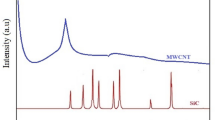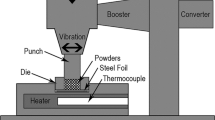Abstract
Physical aspects of explosive compaction of alumina nanopowders with different phase compositions are studied experimentally. Physical processes that occur during consolidation of nanoparticles under pulsed loading are considered. Conditions of retaining of the material nanostructure after compaction and subsequent low-temperature sintering are determined. Physicomechanical properties of explosive compacts and ceramics on the basis of these compacts are studied. A ceramic material characterized by a nanostructure (grain size of ≈200 nm) and high values of density (97% of the theoretical value) and microhardness (up to 23.5 GPa) is obtained.
Similar content being viewed by others
References
A. I. Gusev, Nanocrystalline Materials: Methods of Synthesis and Properties [in Russian], Izd. Ural. Otd. Ross Akad. Nauk, Ekaterinburg (1998).
R. S. Mishra, C. E. Lesher, and A. K. Mukherjee, “Nanocrystalline alumina by high pressure sintering,” Mater. Sci. Forum, 225–227, 617–622 (1996).
V. V. Ivanov, “Obtaining nanostructural ceramics by magnetic-pulsed compaction of powders,” Doct. Dissertation in Phys. and Math., Ekaterinburg (1998).
R. A. Andrievskii, “New superhard nanostructural materials based on refractory compounds: achievements and prospects,” in: Physicochemistry of Finely Disperse Systems, Proc. Vth All-Russia Conf., Part 1, Ural Div., Russian Acad. of Sci., Ekaterinburg (2001), pp. 23–31.
H. Gleiter, “Nanostructured materials: basic concepts and microstructure,” Acta Mater., 48, 1–29 (2000).
H. Gleiter, “Nanostructured materials: State of the art and perspectives,” Nanostructur. Mater., 6, 3–14 (1995).
S. M. Barinov and V. Ya. Shevchenko, Strength of Engineering Ceramics [in Russian], Nauka, Moscow (1996).
V. F. Petrunin, “Finely disperse powders and nanocrystals — two types of finely disperse systems,” in: Physicochemistry of Finely Disperse Systems, Proc. Vth All-Russia Conf., Part 1, Ural Div., Russian Acad. of Sci., Ekaterinburg (2001), pp. 5–11.
M. I. Alymov, “Methods of obtaining and mechanical properties of nanocrystalline systems,” in: Physicochemistry of Finely Disperse Systems, Proc. IVth All-Russia Conf., Moscow Inst. of Physics and Engineering, Moscow (1999), pp. 293–296.
J. H. Adair, R. R. Wills, and V. D. Linse, “Dynamic compaction of ceramic powders,” in: R. F. Davis, H. Palmour, and R. L. Porter (eds.), Proc. 19th Univ. Conf. Emergent Process Methods for High Technology Ceramics, Plenum Press, New York (1984), pp. 639–655. (Mater. Sci. Res., Vol. 17.)
K. Y. Kim, A. D. Batchelor, K. L. More, and H. Palmour, “Rate controlled sintering of explosively shock-conditioned alumina powders,” ibid., pp. 749–764.
C. L. Hoenig and C. S. Yust, “Explosive compaction of AlN, amorphous Si3N4, boron, and Al2O3 ceramics,” Ceram. Bull., 60, No. 11, 1175–1224 (1981).
R. Prümmer, Explosivverdichtung Pulvriger Substanzen, Springer-Verlag, BRD (1987).
E. G. Galkina, G. A. Adadurov, E. V. Kapitanov, et al., “Effect of the method of compaction of finely disperse nickel powders on the fine structure and microhardness of compacts,” in: Physicochemistry of Finely Disperse Systems [in Russian], Nauka, Moscow (1987), pp. 192–196.
A. A. Shtertser, “Explosive compaction of powder materials,” Doct. Dissertation in Phys. and Math., Novosibirsk (1999).
E. E. Lin, V. A. Medvedkin, and S. A. Novikov, “Compaction of ultradisperse diamonds by weak shock wave,” in: Metallurgical and Materials Applications of Shock-Wave and High-Strain-Rate Phenomena (1995), pp. 89–92.
J. Gao, J. Qin, X. Xu, and R. Zhu, “Explosive consolidation of Si3N4 powder,” ibid., pp. 139–147.
Y. J. Zhang, X. J. Li, G. L. Sun, and X. H. Wang, “Preparing tin-doped indium oxide ceramic bulk via explosive consolidation and sintering of nanopowders,” Combust., Expl., Shock Waves, 43, No. 2, 225–232 (2007).
R. Prümmer and P. Weimar, “Explosive consolidation of nanopowders,” Interceram., 51, No. 6, 394–397 (2002).
A. A. Bukaemskii, “Obtaining new finely disperse materials and investigation of their properties,” Candidate’s Dissertation in Phys. and Math., Krasnoyarsk (1995).
A. A. Bukaemskii, S. S. Avramenko, and L. S. Tarasova, “Ultrafine α-Al2O3. Explosive method of synthesis and properties,” Combust., Expl., Shock Wave, 38, No. 4, 478–483 (2002).
A. A. Bukaemskii, A. G. Beloshapko, and A. P. Puzyr’, “Physicochemical properties of Al2O3 powder produced by explosive synthesis,” Combust., Expl., Shock Wave, 36, No. 5, 660–666 (2000).
A. A. Deribas, Physics of Hardening and Explosive Welding [in Russian], Nauka, Novosibirsk (1980).
V. V. Moskvichev, N. A. Makhutov, A. A. Bukaemskii, E. N. Fedorova, et al., Crack resistance and Mechanical Properties of Structural Materials of Engineering Systems [in Russian], Nauka, Novosibirsk (2002).
R. Collongues, La non-stoechiometrie, Masson, Paris (1971).
N. A. Toropov, N. A. Barzakovskii, V. P. Lapin, N. N. Kurtseva, and A. I. Boikova, Diagrams of State of Silicate Systems: Reference Book [in Russian], Nauka, Leningrad (1970).
I. S. Grigor’ev and E. Z. Meilikhov (eds.), Physical Quantities: Handbook [in Russian], Énergoatomizdat, Moscow (1991).
A. A. Bukaemskii, L. S. Tarasova, and E. N. Fedorova, “Investigation of specific features of the phase composition and stability of finely disperse Al2O3 produced by explosive synthesis,” Izv. Vyssh. Ucheb. Zaved., Tsvet. Metallurgiya, No. 5, 60–63 (2000).
R. A. Andrievskii, Powder Material Science [in Russian], Metallurgiya, Moscow (1991).
B. G. Adamenko, P. O. Pashkov, and L. N. Tambovtseva, “Effect of shock-wave treatment on phase transformations in alumina,” Poroshk. Metallurg., No. 10, 93–97 (1978).
V. I. Novikov, L. I. Trusov, V. N. Lapovok, and T. P. Geleishvili, “Specific features of the growth of particles of finely disperse powders during sintering,” Poroshk. Metallurg., No. 3, 29–35 (1984).
G. K. Williamson and W. H. Hall, “X-ray line broadening filed aluminium and wolfram,” Acta Metallurgica, No. 1, 22–31 (1953).
S. S. Batsanov, “Shock compression of inorganic materials,” in: Physical Methods of Studying Inorganic Materials [in Russian], Nauka, Moscow (1981), pp. 71–82.
R.W. Heckel amd J. L. Youngblood, “X-Ray line broadening study of explosively shocked MgO and α-Al2O3 powders,” J. Amer. Ceram. Soc., 51, No. 7, 398–401 (1968).
R. Prümmer and G. Ziegler, “Structure and annealing behavior of explosively compacted alumina powder,” Powder Metallurgy Int., 9, No. 1, 11–14 (1977).
V. F. Nesterenko, Pulsed Loading of Heterogeneous Materials [in Russian], Nauka, Novosibirsk (1992).
K. I. Kondo, S. Soga, and A. Sawaoka, “Shock compaction of silicon carbide powder,” J. Mater. Sci., 20, 1033–1048 (1985).
G. V. Samsonov, A. L. Borisova, T. G. Zhidkova, et al., Physicochemical Properties of Oxides: Handbook [in Russian], Metallurgiya, Moscow (1978).
K. Wefers, “Nomenclature, preparation, and properties of aluminum oxides, oxide hydroxides, and trihydroxides,” in: L. D. Hart (ed.), Alumina Chemicals Science and Technology Handbook, The Amer. Ceram. Soc., Inc. (1990), pp. 13–22.
F. V. Chukhrov (ed.), Minerals: Reference Book [in Russian], Nauka, Moscow (1965). 729–731
Author information
Authors and Affiliations
Corresponding author
Additional information
__________
Translated from Fizika Goreniya i Vzryva, Vol. 44, No. 6, pp. 114–126, November–December, 2008.
Rights and permissions
About this article
Cite this article
Bukaemskii, A.A., Fedorova, E.N. Explosive compaction and low-temperature sintering of alumina nanopowders. Combust Explos Shock Waves 44, 717–728 (2008). https://doi.org/10.1007/s10573-008-0108-8
Received:
Revised:
Published:
Issue Date:
DOI: https://doi.org/10.1007/s10573-008-0108-8




